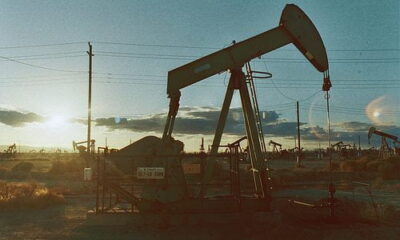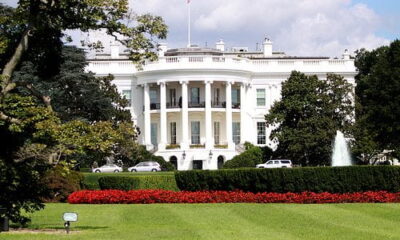
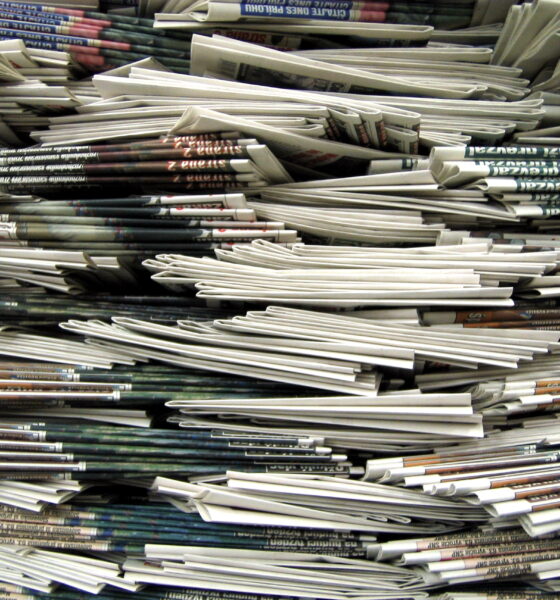
Features
A short history of trying to regulate an irreverent, unruly and opinionated press
The British press and politicians are striving to implement the Leveson Report. This is the just the latest in repeated attempts to regulate the press – or encourage it to regulate itself.
This piece originally featured in B>’s Guide to Responsible Media 2012.
The amusement and delight of the few
Ever since its invention in 1440 by German blacksmith and goldsmith Gutenburg, the printing press has been a powerful tool that both the state and individuals have wished to control. The ability for an identical message to be reproduced thousands, then millions of times, and distributed without relying on the tiny reach and vagaries of handwritten text, orators or messengers changed the way governments and interest groups communicated with the population.
The term ‘newspaper’ gained popularity in the 17th century after the earlier pamphlets, bulletins and gazettes. In this politically difficult time of civil war in England, publishers were often flogged down Fleet Street, the growing heart of publishing in London. Cheeks could be branded or ears cropped for being a seditious libeller (writing with intent to encourage insurrection against the established order).
Recognising the power of the press even then, parliament passed acts to license presses in 1643, which was attacked by John Milton in Areopagitica, and again in 1662. Frequent unlicensed publishers, such as the leveller John Lilburne, emerged during this time to demand free rights and freedom of expression.
Licensing was finally lifted in 1695 and the free British press was born. In a blatant attempt to price newspapers out of ordinary people’s reach and retain control of both the messenger and message, journalists and publishers found themselves encumbered by new taxes on paper and advertising, draconian seditious and blasphemous libel laws and political influence – if you can’t beat them, use them.
People have sense enough to make reflections for themselves
The first daily, the Daily Courant, was published in 1702 and its proprietor Edward Mallet inspired Blue & Green Tomorrow with the following sentiment. He stated intent to publish only news and would not add any comments of his own, supposing other people to have “sense enough to make reflections for themselves.”
In 1712, the Stamp Act was introduced; newspapers subjected to tax and price increased. The stamp tax was a tax on each newspaper and thus hit cheaper papers and popular readership harder than wealthy consumers (because it formed a higher proportion of the purchase price). It was increased in 1797, reduced in 1836 and was finally ended in 1855, thus allowing a cheap press.
Despite these attempts to limit the press, it grew inexorably due the ease of creating and launching a title, which has parallels with digital media today. The total number of copies of newspapers sold yearly in 1753 was 7.4m and had risen to 11.3m in 1776.
The oldest existing national newspaper, The Times, was founded as the Daily Universal Register in 1785 changing its names in 1788. In 1814, The Times started using steam presses, which greatly increased in print capacity.
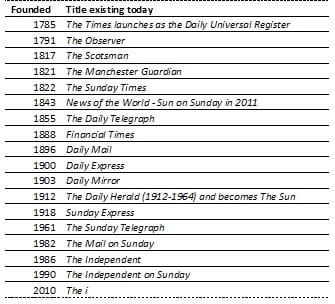 A turning point in the fight for British press freedom was reached in 1817 when William Hone, an English writer, satirist and bookseller, won a court battle against government censorship. The attempts by the then home secretary Lord Sidmouth to put an end to “seditious pamphleteers” had failed.
A turning point in the fight for British press freedom was reached in 1817 when William Hone, an English writer, satirist and bookseller, won a court battle against government censorship. The attempts by the then home secretary Lord Sidmouth to put an end to “seditious pamphleteers” had failed.
This really was the age of the train
Between 1838 and 1855, train passenger journeys rose from 5.5m to 111m, peaking at 1.5 billion before the first world war as the network and interest grew. At the same time, falling freight costs meant newspapers printed in London, Manchester and Edinburgh could easily be dispatched overnight to the breakfast tables of households around the UK. Circulations rose rapidly and the power of the press grew with it. The total number of copies of newspapers sold yearly in 1836 was 39m and had risen to 122m in 1854 in a country of just over 21m. By 1864, the press was largely free to do as it liked.
With rising literacy after the 1870 Education Act and the advent of male (1837, 1867, 1884) then universal suffrage (1918 and 1928), the growing desire to read what political, business and religious leaders were doing gave a continued boost to circulation. As did the desire to enjoy salacious scandals of the rich and powerful.
“Newspapers should have no friends” – Joseph Pulitzer
It is during this period of rapid growth that the first great media proprietors or press barons appear in the UK – Alfred Harmsworth (Lord Northcliffe) who launched the Daily Mail in 1896 and Max Aitken (Lord Beaverbrook) who bought the 10-year old Daily Express in 1910.
Northcliffe, who also founded the Daily Mirror in 1903, was ennobled as baron in 1905 and elevated to Viscount in 1918, for his service as the head of the British war mission in the US (having two 1m or so circulation newspapers probably helped). He is the great, great uncle of the current proprietor of the Daily Mail, Jonathan Harmsworth (the fourth Lord Rothermere).
A brilliant businessman, during his lifetime, he exercised vast influence over British popular opinion. Megalomania contributed to a nervous breakdown shortly before his death in 1922 and he was succeeded by his brother Harold Harmsworth, Lord Rothermere, the current owner’s great grandfather. Alfred Harmsworth’s verdict after the first week of the Daily Mail’s publication was, “We’ve struck a gold mine!”
In his time Lord Beaverbrook was an MP (1910-1916), chancellor of the Duchy of Lancaster (1918), minister of information (1918), minister of aircraft production (1940-41), minister of supply (1941-42), minister of war production (1942) and Lord Privy Seal (1943-45). He is reputed to have said in 1947 that he ran “the paper purely for the purpose of making propaganda, and with no other motive.”
It was in the 1920s that the rising divorce rate gave journalists ample opportunity to report these salacious sexual details revealed in the consequent flurry of court cases. After a long period when governments had largely given up trying to regulate the press, the hardline home secretary, Sir William Joynson-Hicks moved a law to ban such unpleasantness. BBC radio launched in 1922, as a private company, and began experimental television broadcasts in 1932, with regular broadcasts from Alexandra Palace commencing in 1936.
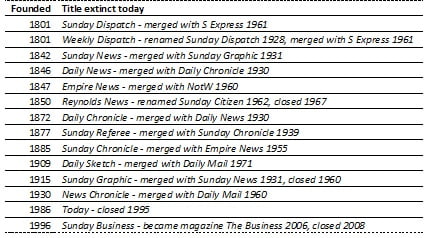 However, it was only after the second world war that there was a new series of attempts not to regulate the press by law, but to find a way to avoid that – by fostering self-regulation. Newspapers were limited from September 1939, at first to 60% of their pre-war consumption of newsprint. By 1945 newspapers were limited to 25% of their pre-war consumption.
However, it was only after the second world war that there was a new series of attempts not to regulate the press by law, but to find a way to avoid that – by fostering self-regulation. Newspapers were limited from September 1939, at first to 60% of their pre-war consumption of newsprint. By 1945 newspapers were limited to 25% of their pre-war consumption.
By 1947, total annual national newspaper circulation stood at 6 billion, with the golden era being between this year and 1956. The combined daily circulation had risen to 16.6m and Sundays at 30.5m, Sundays, in a country with a population of 51.2m or 6.8bn per year.
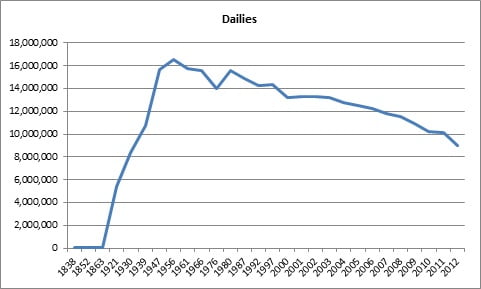
The Sunday newspapers, Empire News (merged with NotW 1960), Sunday Dispatch (merged with Sunday Express) and Sunday Graphic (closed 1960) are now gone, but represented 26% of newspaper sold in that year.
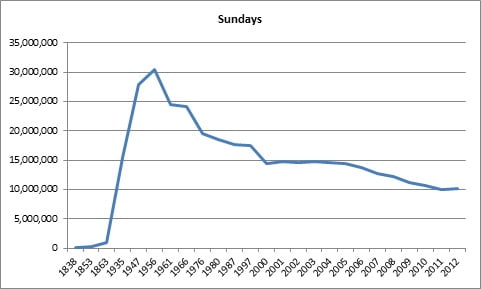
Unsurprisingly, this peak before the long decline sits at the inception of the Television Act 1952, which opened the airwaves to commercial television from 1954. Five years later in 1961 total annual circulation had fallen by over 9%.
“Who guards the guardians?”
The post-war period saw no less than three royal commissions on the press. This led to the setting up of the Press Council in 1953. In the 1947-49 report it said, “A newspaper is one of the most remarkable products of modern society. To gather news from five continents; to print and distribute it so fast that what happens at dawn in India may be read before breakfast in England; to perform the feat afresh every 24 hours; and to sell the product for less than the price of a box of matches–this, were it not so familiar, would be recognised as an astonishing achievement.”
The 1961-62 commission studied the economic and financial factors that affecting the press and ordered improvements to the Press Council.
In was in 1968 that a certain Rupert Murdoch appeared on the scene to acquire The News of the World, The Sun in 1969 and The Times and Sunday Times in 1981.
Following hot after the launch of commercial radio in 1973 the 1974–1977 commission proposed the development of a written Code of Practice for newspapers – only for these to be followed by widespread objections in the 1980s that the press was still out of control.
In 1986, News International titles (The Times, The Sunday Times, The Sun, The News of the World) move to Wapping from Fleet Street, followed in the next few years by The Daily Telegraph, The Sunday Telegraph, Observer, Evening Standard, Financial Times and Express Newspapers. This move is part of the process of transforming the production of newspapers using new technology.
Between 1983 and 1990 over 800,000 homes were fitted with broadband cable. In 1986, British Satellite Broadcasting launched, followed by Sky in 1989 (prop. R Murdoch). They merged in 1990 to become British Sky Broadcasting.
Instances like the publication of a rape victim’s photograph and some of the reporting of the Hillsborough disaster, along with political objections to the invasion of privacy, were followed by yet another Inquiry, led by Sir David Calcutt, in 1990.
In 1990, the government announced that the press was being given one final chance to make self-regulation work – or legal controls would follow.
But those legal controls never happened. The Calcutt Report did lead to the establishment of the Press Complaints Commission, but was then shelved – a fact that has not gone unnoticed by Lord Justice Leveson.
In the background to all this, a British engineer, computer scientist and employee of CERN, Tim Berners-Lee wrote a proposal in March 1989 for what would eventually become the World Wide Web on August 6 1991.
Today the national press has a total annual national newspaper circulation of 3.2 billion, down nearly 40% from its height, and is owned by eight companies.
And so after the long-running phone-hacking scandal, the closure of The News of the World, evidence of bribing the police and lying to parliament, the Leveson inquiry was launched. This judicial public inquiry into the culture, practices and ethics of the British press following the News International phone hacking scandal, chaired by Lord Justice Leveson, who was appointed in July 2011 and reported in November 2012.
In his speech releasing the report he said, “I know how vital the press is – all of it – as guardian to the interests of the public, as a critical witness to events, as a standard bearer for those who have no one else to speak up for them. Nothing I have heard or read has changed that view. The press, operating freely and in the public interest, is one of the true safeguards of our democracy. As a result it holds a privileged and powerful place in our society. This power and influence carries with it responsibilities to the public interest in whose name it exercises these privileges.”
The British press remains the only unregulated part of our mass media. All broadcast media, radio and television, must “ensure that news, in whatever form, is reported with due accuracy and presented with due impartiality.” The BBC, ITV, ITN or Sky conduct hard-hitting investigative journalism under the law.
The Press Complaints Commission publishes an editors’ code of practice, which includes clauses on such things as accuracy, the opportunity to reply, privacy, harassment, intrusion into grief or shock, children, hospitals, reporting of crime, clandestine devices and subterfuge, victims of sexual assault, discrimination, financial journalism, confidential sources, witness payments in criminal trials and payment to criminals.
In June 2004, the provisions were expanded to prevent the interception of ‘private or mobile telephone calls, messages or emails which, considering recent history, gives you a sense of how toothless the PCC is.
While internet publishers enjoy similar freedom of expression as the mainstream press no single news website, blogger, facebooker, tweeter comes closes to the daily reach of the regulated broadcasters (BBC is #1) or unregulated press (Daily Mail is #1). Nor have many been engaged in bribing police, blackmailing politicians or hacking phones in the way the press has. As Leveson said, “What the press do and say is no ordinary exercise of free speech. It operates very differently from blogs, on the internet and other social media such as Twitter. Its impact is uniquely powerful.”
Digital media has many parallels with the early days of the newspaper era. New technology has enabled entrepreneurs to create and launch a huge variety of publications. Politicians and the powerful around the world are constantly exploring ways to control or curb this new medium. But the sheer volume of sites, blogs and individuals means the concentration of power if considerably lower.
Combining the online and offline presence of the eight mass media publishers they reach 82% of the adult population of our country every month. This excludes the regional divisions of some national groups and other media holdings.
Leveson said that “guaranteed independence, long-term stability, and genuine benefits to the industry cannot be realised without legislation.”
He concluded that “the answer to the question, ‘Who guards the guardians?’ should not be ‘no one’.’”


 Environment10 months ago
Environment10 months agoAre Polymer Banknotes: an Eco-Friendly Trend or a Groundswell?

 Environment11 months ago
Environment11 months agoEco-Friendly Home Improvements: Top 7 Upgrades for 2025

 Features9 months ago
Features9 months agoEco-Friendly Cryptocurrencies: Sustainable Investment Choices

 Features10 months ago
Features10 months agoEco-Friendly Crypto Traders Must Find the Right Exchange






